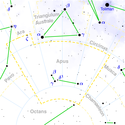NGC 5967
| Galaxie NGC 5967 | |
|---|---|
 | |
| AladinLite | |
| Sternbild | Paradiesvogel |
| Position Äquinoktium: J2000.0, Epoche: J2000.0 | |
| Rektaszension | 15h 48m 15,9s[1] |
| Deklination | -75° 40′ 23″[1] |
| Erscheinungsbild | |
| Morphologischer Typ | SAB(rs)c[1] |
| Helligkeit (visuell) | 12,0 mag[2] |
| Helligkeit (B-Band) | 12,7 mag[2] |
| Winkelausdehnung | 2,7′ × 1,7′[2] |
| Positionswinkel | 90°[2] |
| Flächenhelligkeit | 13,6 mag/arcmin²[2] |
| Physikalische Daten | |
| Rotverschiebung | 0,009623 ± 0,000019[1] |
| Radialgeschwindigkeit | (2885 ± 6) km/s[1] |
| Hubbledistanz vrad / H0 | (122 ± 8) · 106 Lj (37,4 ± 2,6) Mpc [1] |
| Geschichte | |
| Entdeckung | John Herschel |
| Entdeckungsdatum | 7. Juni 1836 |
| Katalogbezeichnungen | |
| NGC 5967 • PGC 56078 • ESO 42-010 • IRAS 15421-7531 • 2MASX J15481597-7540226 • SGC 154206-7531.1 • GC 4120 • h 3608 • | |
NGC 5967 ist eine 12,0 mag helle Balken-Spiralgalaxie vom Hubble-Typ SBc im Sternbild Apus am Südsternhimmel. Sie ist schätzungsweise 122 Millionen Lichtjahre von der Milchstraße entfernt und hat einen Durchmesser von etwa 100.000 Lj.
Die Typ-Ic-Supernova SN 2009gd wurde hier beobachtet.[3]
Das Objekt wurde am 7. Juni 1836 von John Herschel[4] mit einem 18-Zoll-Spiegelteleskop entdeckt, der dabei „faint, pretty large, round, very gradually brighter in the middle, 2′ across“[5] notierte.
Weblinks
- NGC 5967. SIMBAD, abgerufen am 18. Mai 2016 (englisch).
- NGC 5967. DSO Browser, abgerufen am 18. Mai 2016 (englisch).
Einzelnachweise
Auf dieser Seite verwendete Medien
Autor/Urheber: Donald Pelletier, Lizenz: CC BY-SA 4.0
"Image created using the Aladin Sky Atlas software from the Strasbourg Astronomical Data Center and DSS (Digitized Sky Survey) data. DSS is one of the programs of STScI (Space Telescope Science Institute) whose files are in the public domain (http://archive.stsci.edu/data_use.html )"



